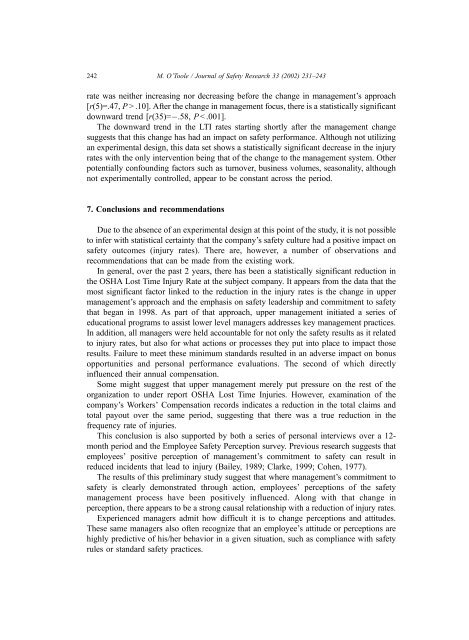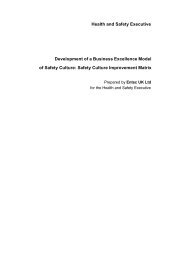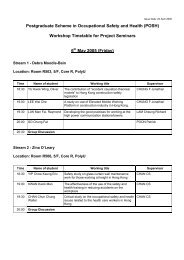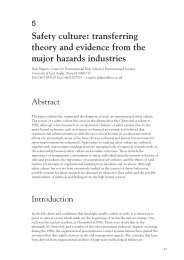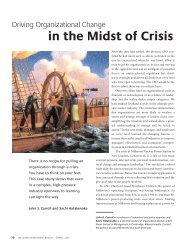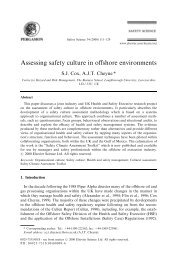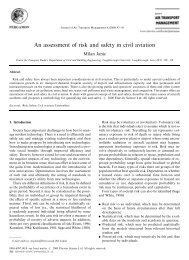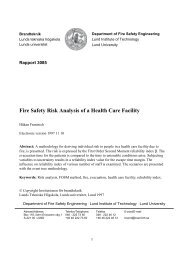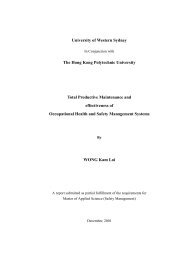The relationship between employees' perceptions of safety and ...
The relationship between employees' perceptions of safety and ...
The relationship between employees' perceptions of safety and ...
Create successful ePaper yourself
Turn your PDF publications into a flip-book with our unique Google optimized e-Paper software.
242<br />
M. O’Toole / Journal <strong>of</strong> Safety Research 33 (2002) 231–243<br />
rate was neither increasing nor decreasing before the change in management’s approach<br />
[r(5)=.47, P > .10]. After the change in management focus, there is a statistically significant<br />
downward trend [r(35)= .58, P < .001].<br />
<strong>The</strong> downward trend in the LTI rates starting shortly after the management change<br />
suggests that this change has had an impact on <strong>safety</strong> performance. Although not utilizing<br />
an experimental design, this data set shows a statistically significant decrease in the injury<br />
rates with the only intervention being that <strong>of</strong> the change to the management system. Other<br />
potentially confounding factors such as turnover, business volumes, seasonality, although<br />
not experimentally controlled, appear to be constant across the period.<br />
7. Conclusions <strong>and</strong> recommendations<br />
Due to the absence <strong>of</strong> an experimental design at this point <strong>of</strong> the study, it is not possible<br />
to infer with statistical certainty that the company’s <strong>safety</strong> culture had a positive impact on<br />
<strong>safety</strong> outcomes (injury rates). <strong>The</strong>re are, however, a number <strong>of</strong> observations <strong>and</strong><br />
recommendations that can be made from the existing work.<br />
In general, over the past 2 years, there has been a statistically significant reduction in<br />
the OSHA Lost Time Injury Rate at the subject company. It appears from the data that the<br />
most significant factor linked to the reduction in the injury rates is the change in upper<br />
management’s approach <strong>and</strong> the emphasis on <strong>safety</strong> leadership <strong>and</strong> commitment to <strong>safety</strong><br />
that began in 1998. As part <strong>of</strong> that approach, upper management initiated a series <strong>of</strong><br />
educational programs to assist lower level managers addresses key management practices.<br />
In addition, all managers were held accountable for not only the <strong>safety</strong> results as it related<br />
to injury rates, but also for what actions or processes they put into place to impact those<br />
results. Failure to meet these minimum st<strong>and</strong>ards resulted in an adverse impact on bonus<br />
opportunities <strong>and</strong> personal performance evaluations. <strong>The</strong> second <strong>of</strong> which directly<br />
influenced their annual compensation.<br />
Some might suggest that upper management merely put pressure on the rest <strong>of</strong> the<br />
organization to under report OSHA Lost Time Injuries. However, examination <strong>of</strong> the<br />
company’s Workers’ Compensation records indicates a reduction in the total claims <strong>and</strong><br />
total payout over the same period, suggesting that there was a true reduction in the<br />
frequency rate <strong>of</strong> injuries.<br />
This conclusion is also supported by both a series <strong>of</strong> personal interviews over a 12-<br />
month period <strong>and</strong> the Employee Safety Perception survey. Previous research suggests that<br />
employees’ positive perception <strong>of</strong> management’s commitment to <strong>safety</strong> can result in<br />
reduced incidents that lead to injury (Bailey, 1989; Clarke, 1999; Cohen, 1977).<br />
<strong>The</strong> results <strong>of</strong> this preliminary study suggest that where management’s commitment to<br />
<strong>safety</strong> is clearly demonstrated through action, employees’ <strong>perceptions</strong> <strong>of</strong> the <strong>safety</strong><br />
management process have been positively influenced. Along with that change in<br />
perception, there appears to be a strong causal <strong>relationship</strong> with a reduction <strong>of</strong> injury rates.<br />
Experienced managers admit how difficult it is to change <strong>perceptions</strong> <strong>and</strong> attitudes.<br />
<strong>The</strong>se same managers also <strong>of</strong>ten recognize that an employee’s attitude or <strong>perceptions</strong> are<br />
highly predictive <strong>of</strong> his/her behavior in a given situation, such as compliance with <strong>safety</strong><br />
rules or st<strong>and</strong>ard <strong>safety</strong> practices.


